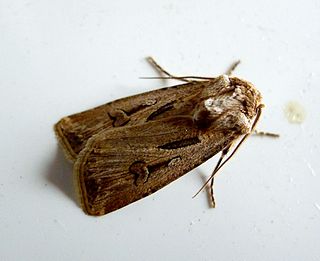
Agrotis segetum, sometimes known as the turnip moth, is a moth of the family Noctuidae. The species was first described by Michael Denis and Ignaz Schiffermüller in 1775. It is a common European species and it is found in Africa and across Eurasia except for the northernmost parts.

The heart and dart is a moth of the family Noctuidae. The species was first described by Carl Linnaeus in his 1758 10th edition of Systema Naturae. A familiar moth to many, it is considered one of the most common of the European region. It occurs throughout the Palearctic ecozone from Ireland to Japan.

Agrotis is a genus of moths of the family Noctuidae. The genus was erected by Ferdinand Ochsenheimer in 1816. A number of the species of this genus are extinct.

Agrotis ipsilon, the dark sword-grass, black cutworm, greasy cutworm, floodplain cutworm or ipsilon dart, is a small noctuid moth found worldwide. The moth gets its scientific name from black markings on its forewings shaped like the letter "Y" or the Greek letter upsilon. The larvae are known as "cutworms" because they cut plants and other crops. The larvae are serious agricultural pests and feed on nearly all varieties of vegetables and many important grains.

The Laysan noctuid moth was a species of moth in the family Noctuidae. This species is now extinct.

Agrotis puta, the shuttle-shaped dart, is a moth of the family Noctuidae. The species was first described by Jacob Hübner in 1803. It is common in the western part of Europe, but is also found in southern and central Europe, as well as North Africa and the Middle East.

Feltia subterranea, formerly known as Agrotis subterranea, and commonly known as the granulate cutworm or tawny shoulder, is a moth of the family Noctuidae. It is found in North America, from Massachusetts and New York to California and the southern parts of the United States and Mexico. It is also present in Central America and South America where it has been reported in Honduras, Costa Rica, Cuba, Panama, Venezuela, Colombia, South-East Brazil, Uruguay, Chile, the Antilles.

The old man dart, spotted-legged cutworm or muted dart is a moth of the family Noctuidae. It is found in North America, from southern Alaska to Nova Scotia, southward into Mexico.

Agrotis fatidica is a moth of the family Noctuidae. It is found in Southern and Central Europe, east through Russia to Mongolia, China and Tibet.

Agrotis spinifera, or Gregson's dart, is a moth of the family Noctuidae. The species was first described by Jacob Hübner in 1808. It is found in southern Europe, Arabia to southern Africa, Madagascar, Turkey, Iraq, Iran, Afghanistan, Pakistan, Kashmir, India to Myanmar and Sri Lanka.

Agrotis trux, the crescent dart, is a moth of the family Noctuidae. The species was first described by Jacob Hübner in 1824. It has a circum-Mediterranean distribution and is found along the coasts of France, Ireland, England, southern Europe, Algeria, Syria, Iraq, Iran, southern Russia and the Arabian Peninsula. In Africa, it is found as far south as South Africa.

Agrotis bigramma, the great dart, is a moth of the family Noctuidae. The species was first described by Eugenius Johann Christoph Esper in 1790. It is found from along the southern shores of the Baltic Sea to China, the Levant and North Africa. Migrants have been reported as far west as Great Britain with three in one trap at St Agnes, Isles of Scilly on 10 August 1997.

Agrotis obesa is a moth of the family Noctuidae. It is found from south-eastern Europe, the Near East and the Middle East to China. In North Africa, it is known from Morocco to Algeria.
This page is based on this
Wikipedia article Text is available under the
CC BY-SA 4.0 license; additional terms may apply.
Images, videos and audio are available under their respective licenses.













